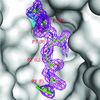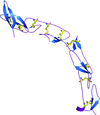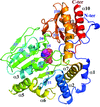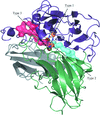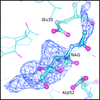issue contents
May 2012 issue

Cover illustration: The co-crystal structure of botulinum neurotoxin serotype A light chain with a potent peptide inhibitor RRGF (p. 511). The active site of the toxin and its bound peptide inhibitor with electron density is shown here. Molecular interactions of the toxin with various peptide inhibitors were mapped, the structure-activity relationship was derived and a pharmacophore model was developed. This study could lead to the discovery of drugs against the most potent toxin known, botulinum neurotoxin.
research papers
Using X-ray crystallography and isothermal titration calorimetry, we show that sodium dodecyl sulfate (SDS) binds specifically to a pre-formed internal cavity in horse-spleen apoferritin.
PDB reference: SDS–apoferritin complex, 3u90
Open  access
access
 access
accessMacromolecular crystals luminesce during X-ray irradiation. This luminescence, and how it changes as a function of absorbed dose, has been characterized for several different proteins.
Botulinum neurotoxins have been declared as a Category A agent by the Centers of Disease Control and Prevention owing to their extremely poisonous nature and are potential bioweapon and bioterrorism agents. Towards the discovery of antidotes, structures of inhibitory peptide–enzyme complexes were determined, the structure–activity relationship was determined and a pharmacophore was developed.
A comparative analysis of sulfur phasing of death receptor 6 (DR6) using data collected at wavelengths of 2.0 and 2.7 Å is presented. SAXS analysis of unliganded DR6 defines a dimer as the minimum physical unit in solution.
The structure of the uncharacterized protein YLR301w is reported.
PDB reference: YLR301w, 3rby
A number of native and inhibitor-complexed aspartic proteinase crystal structures are reported. Analysis of the structure of native endothiapepsin in the same crystal form as that adopted by the majority of inhibitor complexes of this enzyme reveals that the rigid-body movement previously attributed to inhibitor binding may instead be at least partly a consequence of crystal packing involving sulfate anions.
PDB references: endothiapepsin–DB5, 3uri; endothiapepsin–DB4, 3urj; endothiapepsin–DB6, 3url; pepsin 3b, 3utl
The crystal structure of phosphoserine aminotransferase, an essential enzyme for serine biosynthesis in M. tuberculosis, has been solved at 1.5 Å resolution. The structure reveals differences in the substrate-binding region when compared with the equivalent human enzyme, suggesting opportunities for structure-based drug design.
Radiation-induced reduction, radiolysis of copper sites and the effect of pH value together with the concomitant geometrical distortions of the active centres were analysed in several fungal (C. gallica) laccase structures collected at cryotemperature. This study emphasizes the importance of careful interpretation when the crystallographic structure of a metalloprotein is described.
Open  access
access
 access
accessTruncation of ribosomal protein L9 in T. thermophilus allows the generation of new crystal forms and the crystallization of ribosome–GTPase complexes.
The effect of minute variations in the concentration of the protein solution on the crystallization success rate of lysozyme was investigated and it was found that a very small variation in protein concentration of as low as 0.13% (0.026 mg ml−1 in the current study) could exert a significant effect on the crystallization of lysozyme.
Open  access
access
 access
accessA sample environment for mounting crystallization trays has been developed on the microfocus beamline I24 at Diamond Light Source. The technical developments and several case studies are described.
The anticancer complexes cisplatin and carboplatin target the DNA major groove, but have toxic side effects. It is shown that in the presence of DMSO two molecules of either cisplatin or carboplatin bind to its His15 residue. The observation of this effect with DMSO, a widely used super-solvent for drug delivery, should be considered in toxicity assessments of these drugs.
essays
A detailed analysis of the growth rate of the PDB is presented that suggests appreciable changes in the deposition rates for certain periods, possibly related to technical innovations or to sociological events in the development of the field of macromolecular crystallography.


 journal menu
journal menu













